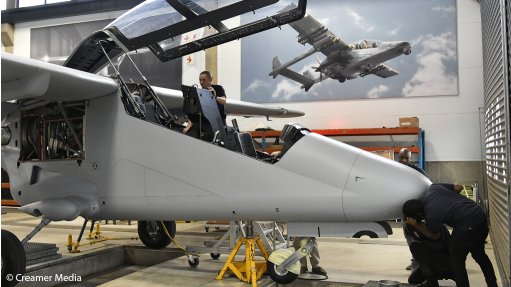
Paramount Aerospace Industries' technicians at the company's Wonderboom manufacturing facility see to the final touches on the first Mwari to be delivered to a customer - an overseas air force.
Photo by: Creamer Media's Donna Slater
Pretoria-based aerospace and defence equipment manufacturer Paramount Aerospace Industries is set to deliver its first Mwari multi-role aircraft to an overseas air force on September 23, while other airframes are destined for another air force.
The orders for nine new Mwaris for the two separate air forces represent an important milestone in Paramount Aerospace Industries’ commercial success and has resulted in full serial production of Mwaris at Paramount Group’s Wonderboom National Airport aircraft factory.
Paramount Aerospace Industries CEO Mike Levy says the milestone is a “proud moment” for Paramount and Africa’s aerospace industry.
“The development and deployment of Mwari underscores the strategic importance of a world-class, indigenous African aerospace industry, one that can quickly and collaboratively address the increasing security threats, conflicts and insurgencies which Africa presently faces.”
The Mwari is a military-spec reconnaissance, surveillance and precision strike aircraft, originating as an offshoot of Paramount’s Advanced High-performance Reconnaissance Light Attack aircraft, known as the Ahrlac.
“[These orders] are effectively work for us for the next two years, at least,” he adds.
Currently, Paramount Aerospace Industries is capable of producing three Mwaris a year, with plans to ramp up capacity to five units a year, as and when demand requires.
The Mwari is a clean-sheet design, explains Levy. “We started completely from scratch, which makes it quite unique. Not too many aircraft are designed completely from scratch.”
He adds that the design and specification of Mwari originated from the requirement for a small multi-role surveillance and reconnaissance aircraft that is easy and quick to deploy, even from unprepared or rough-terrain runways. This is also advantageous to operate in anti-poaching, anti-people trafficking and counter insurgency applications.
Mwari addresses a key global security requirement from air forces around the world by performing missions that previously required several different aircraft. It integrates design concepts from helicopters, surveillance platforms and reconnaissance aircraft with the ability to carry multiple systems, such as surveillance radar and electro optic sensor systems.
Because of the Mwari’s compact design, large wheels and light weight, it is also capable of being turned around and refuelled by its two crew members on the ground.
Taking its ability to serve as a surveillance and reconnaissance platform, the Mwari offers a below-wing cockpit with a rear wingset mount and a pusher-type propellor to ensure unobstructed fields of view for the pilot and systems operator, while staggered seating also enables better visibility and the ability for the Mwari to be flown from the rear seat to aid in pilot training scenarios.
The Mwari is capable of carrying various payloads in its interchangeable mission systems bay – located in the belly of the aircraft, including sensor and payload options which can be integrated and be swapped out in less than two hours in a plug-and-play manner.
This modular pod enables the Mwari to perform a multitude of roles without any aerodynamic or ordinance penalties.
The Mwari can also be armed, with payloads of ordnance on its inner and major pylons of up to 300 kg, while as much as 280 kg of ordnance can be loaded onto its outer wing pylons.
Mwari has a service ceiling of up to 31 000 ft, a maximum cruise speed of 250 knots, a mission range of up to 550 nautical miles with ordinance and an overall endurance of up to six-and-a-half hours. The aircraft also offers short take-off and landing capability.
In terms of operating costs, the Mwari can be operated at an average of $1 500 an hour, which Levy says is about equivalent to the operating cost of a small helicopter.
Paramount International senior VP Eric Ichikowitz says the Mwari is purposefully designed for the kind of asymmetrical warfare that modern military forces across the world are today being asked to conduct.
“The aircraft has a critical role to play in the connected battlefield providing forces on the ground and in the air with a force multiplier competitive advantage.”
Based on both Paramount Group’s commitment to innovation and its extensive research and development and manufacturing experience, the Mwari has been designed with portable production in mind.
As such, the aircraft can, depending on customer requirements, be exported in kit format for final assembly in customer countries, and can easily integrate into supply chains around the world, enabling scalable mass production.